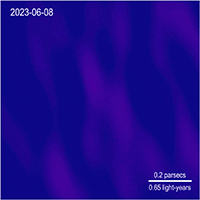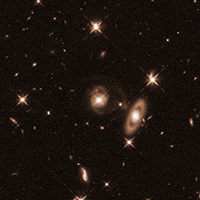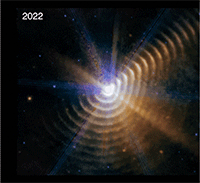Gaylord National Resort & Convention Center
National Harbor, Maryland
12 – 16 January 2025
| NASA Celebrates Edwin Hubble’s Discovery of a New Universe | |
|---|---|
 |
For humans, the most important star in the universe is our Sun. The second-most important star is nestled inside the Andromeda galaxy. Don't go looking for it — the flickering star is 2.2 million light-years away, and is 1/100,000th the brightness of the faintest star visible to the human eye. Yet, a century ago, its discovery by Edwin Hubble, then an astronomer at Carnegie Observatories, opened humanity's eyes as to how large the universe really is, and revealed that our Milky Way galaxy is just one of hundreds of billions of galaxies in the universe ushered in the coming-of-age for humans as a curious species that could scientifically ponder our own creation through the message of starlight. Read more » |
| NASA’s Webb Reveals Intricate Layers of Interstellar Dust, Gas | |
|---|---|
 |
Once upon a time, the core of a massive star collapsed, creating a shockwave that blasted outward, ripping the star apart as it went. When the shockwave reached the star’s surface, it punched through, generating a brief, intense pulse of X-rays and ultraviolet light that traveled outward into the surrounding space. About 350 years later, that pulse of light has reached interstellar material, illuminating it, warming it, and causing it to glow in infrared light. NASA’s James Webb Space Telescope has observed that infrared glow, revealing fine details resembling the knots and whorls of wood grain. Read more » |
| Newfound Galaxy Class May Indicate Early Black Hole Growth, Webb Finds | |
|---|---|
 |
In December 2022, less than six months after commencing science operations, NASA’s James Webb Space Telescope revealed something never seen before: numerous red objects that appear small on the sky, which scientists soon called “little red dots” (LRDs). Though these dots are quite abundant, researchers are perplexed by their nature, the reason for their unique colors, and what they convey about the early universe. Read more » |
| Astronomers Catch Unprecedented Features at Brink of Active Black Hole | |
|---|---|
 |
International teams of astronomers monitoring a supermassive black hole in the heart of a distant galaxy have detected features never seen before using data from NASA missions and other facilities. The features include the launch of a plasma jet moving at nearly one-third the speed of light and unusual, rapid X-ray fluctuations likely arising from near the very edge of the black hole. Read more » |
| Hubble Reveals Surprising Spiral Shape of Galaxy Hosting Young Jet | |
|---|---|
 |
The night sky has always played a crucial role in navigation, from early ocean crossings to modern GPS. Besides stars, the United States Navy uses quasars as beacons. Quasars are distant galaxies with supermassive black holes, surrounded by brilliantly hot disks of swirling gas that can blast off jets of material. Following up on the groundbreaking 2020 discovery of newborn jets in a number of quasars, aspiring naval officer Olivia Achenbach of the United States Naval Academy has used NASA’s Hubble Space Telescope to reveal surprising properties of one of them, quasar J0742+2704. Read more » |
| How Many Black Holes Are Hiding? NASA Study Homes in on Answer | |
|---|---|
 |
An effort to find some of the biggest, most active black holes in the universe provides a better estimate for the ratio of hidden to unhidden behemoths. Multiple NASA telescopes recently helped scientists search the sky for supermassive black holes — those up to billions of times heavier than the Sun. The new survey is unique because it was as likely to find massive black holes that are hidden behind thick clouds of gas and dust as those that are not. Read more » |
| NASA’s Hubble Tracks Down a ‘Blue Lurker’ Among Stars | |
|---|---|
 |
The name "blue lurker" might sound like a villainous character from a superhero movie. But it is a rare class of star that NASA's Hubble Space Telescope explored by looking deeply into the open star cluster M67, roughly 2,800 light-years away. Read more » |
| Webb Watches Carbon-Rich Dust Shells Form, Expand in Star System | |
|---|---|
 |
Astronomers have long tried to track down how elements like carbon, which is essential for life, become widely distributed across the universe. Now, NASA’s James Webb Space Telescope has examined one ongoing source of carbon-rich dust in our own Milky Way galaxy in greater detail: Wolf-Rayet 140, a system of two massive stars that follow a tight, elongated orbit. Read more » |